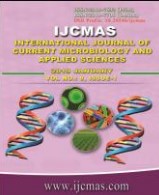


 National Academy of Agricultural Sciences (NAAS)
National Academy of Agricultural Sciences (NAAS)

|
PRINT ISSN : 2319-7692
Online ISSN : 2319-7706 Issues : 12 per year Publisher : Excellent Publishers Email : editorijcmas@gmail.com / submit@ijcmas.com Editor-in-chief: Dr.M.Prakash Index Copernicus ICV 2018: 95.39 NAAS RATING 2020: 5.38 |
The present study was conducted in District Allahabad, Uttar Pradesh State of India to evaluate the impact of Diversified Agriculture Support Project (DASP) launched under World Bank supported flagship programme on beneficiaries and non-beneficiaries. The major findings of the study revealed that majority of beneficiaries (41.33 percent) were in the age group of 40-50 years whereas the majority of non-beneficiaries (40.67 percent) belong to the age group of 50-60 years. The educational status of majority of beneficiaries (23.33 percent) was concentrated upto high school whereas majority of non-beneficiaries (32 percent) falls under illiterate category of educational standard. Further, majority of beneficiaries (45.33 percent) and non-beneficiaries (42.00 percent) had farming as their main occupation. It was also found that majority of the beneficiates (60.00 percent) and non-beneficiaries (66.66 percent) had size of land holding upto 2 hectares. The data further reflected that almost 85-95% of the land holdings in both the cases belong to small and medium farmers. The results of the study further revealed that majority of beneficiaries had annual income above 3 lakhs whereas non- beneficiaries had an annual income of less than 3 lakhs. Regarding mass media exposure majority of the beneficiaries falls under medium level of mass media exposure, whereas non-beneficiaries fall under low level of mass media exposure. The results showed that the yield levels in respect of major Agricultural, Horticulture crops even milk per day per animal in case of beneficiaries was significantly much higher than non-beneficiaries thus indicating prominent impact of technological backstopping, demonstration, trainings, and supply of timely / quality inputs under DASP. The results of the study also concluded that cost of the production on account of different crops for beneficiaries had decreased and net returns of the produce had increased significantly due to efficient marketing strategies under DASP as compared to non- beneficiaries.
 |
 |
 |
 |
 |